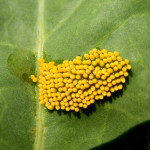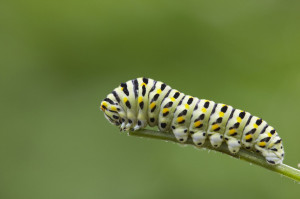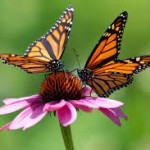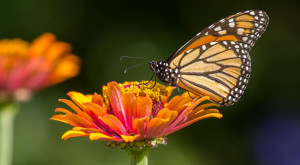by Nasia Kouli
Butterflies are insects in the macrolepidopteran clade Rhopalocera, which also includes moths.
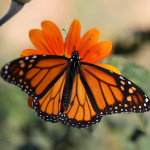
Growth:
Butterflies in their adult stage can live from a week to nearly a year depending on the species. Many species have long larval life stages while others can remain dormant in their pupal or egg stages and thereby survive winters. They have a four-stage life cycle, as like most insects they undergo complete metamorphosis.
- Egg
- Caterpillar
- Pupa
- adult
1.Egg:
Butterfly eggs are protected by a hard-ridged outer layer of shell, called the chorion. This is lined with a thin coating of wax which prevents the egg from drying out before the larva has had time to fully develop. Each egg contains a number of tiny funnel-shaped openings at one end, called micropyles; the purpose of these holes is to allow sperm to enter and fertilize the egg. Butterfly eggs vary greatly in size and shape between species, but are usually upright and finely sculptured. Some species lay eggs singly, others in batches. Many females produce between one hundred and two hundred eggs.
2.Caterpillar:
Butterfly larvae, or caterpillars, consume plant leaves and spend practically all of their time searching for and eating food. Although most caterpillars are herbivorous, a few species are predators, such as “Spalgis epius”,which eats scale insects, or lycaenids. Caterpillars mature through a series of developmental stages known as instars. Near the end of each stage, the larva undergoes a process called apolysis, mediated by the release of a series of neurohormones.
3.Pupa:
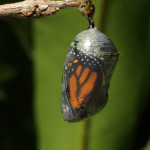
When the pupa is fully grown, hormones such as prothoracicotropic hormone (PTTH) are produced. At this point the larva stops feeding, and begins «wandering» in the quest for a suitable pupation site, often the underside of a leaf or other concealed location. There it spins a button of silk which it uses to fasten its body to the surface and moults for a final time. While some caterpillars spin a cocoon to protect the pupa, most species do not. The naked pupa, often known as a chrysalis, usually hangs head down from the cremaster, a spiny pad at the posterior end, but in some species a silken girdle may be spun to keep the pupa in a head-up position.
4.Adult:
The reproductive stage of the insect is the winged adult or imago. The surface of both butterflies and moths is covered by scales, each of which is an outgrowth from a single epidermal cell. The head is small and dominated by the two large compound eyes. These are capable of distinguishing flower shapes or motion but cannot view distant objects clearly. Colour perception is good, especially in some species in the blue/violet range. The antennae are composed of many segments and have clubbed tips (unlike moths that have tapering or feathery antennae).
The number of generations per year varies from temperate to tropical regions with tropical regions showing a trend towards multivoltinism.
Life(food,predators,species etc):
Butterflies are distributed worldwide except Antarctica, totalling some 18,500 species. The monarch butterfly is native to the Americas, but in the nineteenth century or before, spread across the world, and is now found in Australia, New Zealand, other parts of Oceania, and the Iberian Peninsula.
They are often polymorphic, and many species make use of camouflage, mimicry, and aposematism to evade their predators. Some, like the monarch and the painted lady, migrate over long distances. Many butterflies are attacked by parasites or parasitoids, including wasps, protozoans, flies, and other invertebrates, or are preyed upon by other organisms. Some species are pests because in their larval stages they can damage domestic crops or trees, other species are agents of pollination of some plants. Larvae of a few butterflies (e.g. harvesters) eat harmful insects, and a few are predators of ants, while others live as mutualists in association with ants. Culturally, butterflies are a popular motif in the visual and literary arts. The Smithsonian Institution says «butterflies are certainly one of the most appealing creatures in nature». As in all insects, the body is divided into three sections: the head, thorax, and abdomen. The thorax is composed of three segments, each with a pair of legs. In most families of butterfly the antennae are clubbed, unlike those of moths which may be threadlike or feathery. The long proboscis can be coiled when not in use for sipping nectar from flowers.
Nearly all butterflies are diurnal, have relatively bright colors, and hold their wings vertically above their bodies when at rest, unlike the majority of moths which fly by night, are often well camouflaged, and either hold their wings flat (which means touching the surface on which the moth is standing) or fold them closely over their bodies. Some day-flying moths, such as the hummingbird hawk-moth, are exceptions to these rules.
Symbolism:
Different Native American tribes interpret butterflies in their own way, but generally, they’re thought to represent change and transformation, comfort, hope, and positivity. While some believed ancestors communicated through butterflies, others took the presence of these creatures as a joyous or hopeful sign.
The butterfly has also long been a significant symbol for suicide prevention.
(the symbolism of butterflies is the main reason why I chose to introduce this topic. I believe that positivity and hope is an essential element that the world needs in order to survive. Even in the worst conditions, even when someone is suffering, even if they are in the verge of giving everything up, hope is the only thing that can make them keep up in life)
23/12/22

